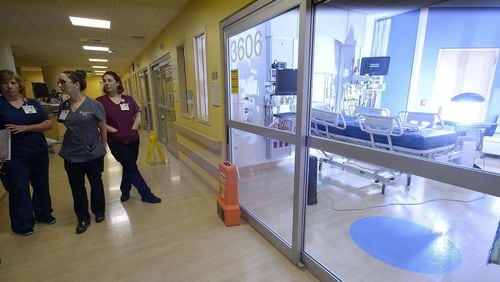Georgia’s unemployment rate edged down to 5.3 percent in February from 5.5 percent in January, the state labor department said.
The state added 12,000 jobs during the month, bouncing back from a lackluster January with about twice as many jobs as are usually added in February.
With just a few exceptions, the various pieces of the Georgia economy seem to have regained traction, continuing the steady growth that has raised the number of employed people in the state to more than 4.7 million — although 267,370 others were out of work and actively looking for a job.
Layoffs fell from the same month a year ago, said Mark Butler, the state labor commissioner.
“Our unemployment rate fell as Georgia set new record highs for the number of people employed and for the size of our labor force, which crossed the five-million mark for the first time.”
January, as is usually the case, was a relatively weak month for the job market. Holiday spending and travel waned, as did the need to move lots of packages. All of that often means less demand for workers in stores, hotels, restaurants, warehouses and trucking companies.
At same time, businesses that put off making cuts until after Christmas often issue pink slips in the new year.
February, on the other hand, can often be a rebound month.
While it is too early to see the effect of Trump-era policies on immigration, trade or taxes, the state’s February report does cover the first full month of the administration. As policies shift, the Georgia sectors most likely to be affected are manufacturing – which has declined the past several months – and logistics, the movement of people and packages that depends on vibrant trade.
But in general, the February snapshot shows a healthy expansion.
The corporate sector – known as professional and business services – grew by 6,100 positions. That was followed by education and health services, with 4,400 more jobs; information services, which added 2,000; and financial activities, bolstered by 1,200.
Manufacturing was down 2,100 jobs.
Retail was also weak, which may reflect the annual post-holiday shopping sag, but could also be a sign of a wave of store closings as online shopping continues to disrupt traditional retailing.
Georgia’s jobless rate is still significantly above the national rate of 4.7 percent. It has not been below the national average since 2007, which was before the economy slipped into recession.
But the jobless rate’s slow improvement can be misleading. A year ago, the Georgia rate was 5.5 percent, but since then, more than 100,000 workers have been added to the job market – people moving into Georgia, coming out of school or getting out of the house and back into the search for a paycheck.
The rising number of people in the labor force means more have to find jobs to lower the unemployment rate, and the decline suggests most are doing so.
On the other hand, nearly 30 percent of the unemployed say they have been looking for six months or more.
Georgia job growth in February
2007: 3,000
2008: 1,000
2009: (26,400)
2010: (2,700)
2011: 37,900
2012: 4,100
2013: 10,000
2014: (5,000)
2015: 12,000
2016: 10,700
2017: 12,000
Sources: Georgia Department of Labor, Bureau of Labor Statistics
State unemployment rate, February
2007: 4.4 percent
2008: 5.4 percent
2009: 9.3 percent
2010: 10.5 percent
2011: 10.3 percent
2012: 9.5 percent
2013: 8.5 percent
2014: 7.3 percent
2015: 6.2 percent
2016: 5.5 percent
2017: 5.3 percent
Sources: Georgia Department of Labor, Bureau of Labor Statistics
About the Author




/cloudfront-us-east-1.images.arcpublishing.com/ajc/P7DYBH6TO7FEKG4SUXQQKADRXE.jpg)


